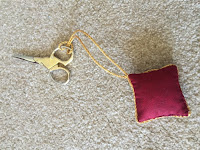The Embroiderers' Guild of South Australia's Ethnic Embroidery Study Group is looking this year at beading in a range of different Ethnic traditions. When, earlier this year, I saw a project in Embroidery and Cross Stitch Magazine Volume 23, No 5, based on Japanese beading techniques, I thought it would be interesting to try it out as a contribution to the group's study. The project is by Merrilyn Whittle, who produced a kit for the project. I sent for the kit.
 This form of Japanese beading is worked on patterned fabric, using part of the pattern as a template for the beads. You mark off the section to be beaded with couched thread, then fill in with beads. It sounds easy - but not (for me at least) so in practice. The beads are tiny, need to be subtly varied in colour and secured firmly. I found threading a beading needle very challenging. I took to using long threads to minimise the number of threadings.
This form of Japanese beading is worked on patterned fabric, using part of the pattern as a template for the beads. You mark off the section to be beaded with couched thread, then fill in with beads. It sounds easy - but not (for me at least) so in practice. The beads are tiny, need to be subtly varied in colour and secured firmly. I found threading a beading needle very challenging. I took to using long threads to minimise the number of threadings. A symmetrical pattern, like this one, also presents some challenges for description of parts and direction. "Top of" and "bottom of" are terms only meaningful if 'top' is agreed!
A symmetrical pattern, like this one, also presents some challenges for description of parts and direction. "Top of" and "bottom of" are terms only meaningful if 'top' is agreed! The pattern, however, was lovely and the rich colours most rewarding as they emerged in beads, giving the piece dimension and depth.
The pattern, however, was lovely and the rich colours most rewarding as they emerged in beads, giving the piece dimension and depth.  My efforts were a bit wonky in places - but undoing was only rarely an option. The technique requires continuous thread, rather than stopping and starting, and beads are firmly couched down as you go. I could correct a bead placement if I picked up the error immediately - but otherwise correcting was, for me at least, limited.
My efforts were a bit wonky in places - but undoing was only rarely an option. The technique requires continuous thread, rather than stopping and starting, and beads are firmly couched down as you go. I could correct a bead placement if I picked up the error immediately - but otherwise correcting was, for me at least, limited.
 Once the pattern was beaded, the edging cord was attached and the background beaded. All this, of course, took several days. I did it while recovering from my knee operation - and it filled many hours.
Once the pattern was beaded, the edging cord was attached and the background beaded. All this, of course, took several days. I did it while recovering from my knee operation - and it filled many hours.Although I was finding somewhat tedious the process of taking a few beads of a particular colour, out of a small plastic bag, placing them on a 'shoe', threading and stitching down, it became addictive - I really wanted to finish the next little section. I even developed a way of doing it in front of television!

 The construction process was relatively straightforward. I chose not to use glue, but to tack down the edges over the wadding.
The construction process was relatively straightforward. I chose not to use glue, but to tack down the edges over the wadding.I had by now found two more similar projects by Merrilyn - one from her website and one from Inspirations Magazine No 91. The latter is used as a scissor fob, rather than a decoration. I bought kits for both of them (in for a penny... when you're on a good thing....)
 All my projects, I decided, would be scissor fobs. (I am using the term here as defined way back in a blog in 2012, when I settled for 'keep' as a term for a pouch to keep scissors in, and 'fob' as a tab to attach to the scissors themselves). I have a lot of unattached embroidery scissors - here's an opportunity to tidy that up. So I included a couple of coins in the stuffing to give it weight.
All my projects, I decided, would be scissor fobs. (I am using the term here as defined way back in a blog in 2012, when I settled for 'keep' as a term for a pouch to keep scissors in, and 'fob' as a tab to attach to the scissors themselves). I have a lot of unattached embroidery scissors - here's an opportunity to tidy that up. So I included a couple of coins in the stuffing to give it weight.Anyone sense obsessive behaviour?




1 comment:
Well, the result is spectacular, so I would not say that focusing on a good thing is obsessive, necessarily. If you are still making them a year from now, that might be different! Really nice finish, can't wait to see the next ones!
Post a Comment